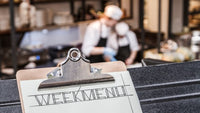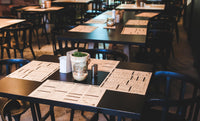- Finance
-
Shop Used Equipment
- Beverage
- Coffee
-
Cooking
- Shop all cooking
- Bratt pans
- Char grills
- Chicken rotisseries
- Combi ovens
- Contact grills
- Convection ovens
- Conveyor toasters
- Conveyor, deck and pizza ovens
- Cooktops
- Cooktop oven combos
- Crepe and pancake makers
- Fryers and oil filters
- Griddles
- Microwaves
- Pasta cookers
- Range ovens
- Rice cookers
- Salamander grills
- Sous vide
- Tandoor ovens
- Toaster Grills
- Vertical broilers
- Waffle and crepe makers
- Wok burners
- Other cooking equipment
- Dishwashers
- Food display
-
Food preparation
- Shop all food preparation
- Blenders
- Dough rollers and sheeters
- Food processors
- Fruit and veg prep
- Ice-cream machines
- Juicers
- Mixers
- Pizza prep tables
- Proofing and warming cabinets
- Sandwich and salad prep tables
- Slicers and grinders
- Sushi makers
- Vacuum packaging machines
- Other food preparation equipment
- Point of sale
-
Refrigeration
- Shop all refrigeration
- Back bar coolers and kegerators
- Blast chillers/freezers
- Chef bases
- Chest freezers
- Countertop fridges
- Display freezers
- Display fridges
- Gelato freezers
- Ice-cream machines
- Ice machines and bins
- Pizza prep tables
- Reach-in freezers
- Reach-in refrigerators
- Sandwich and salad prep tables
- Slushy machines
- Under counter freezers
- Under counter fridges
- Other refrigeration equipment
- Restaurant furniture
- Stainless steel
- End of Season Sale
- Shop all equipment
- Customers
- FAQs
- About Us
Share
Why you need a great menu: Inside and out
article
When it comes to the cogs and wheels of a great restaurant, we tend to imagine the biggest components having the greatest influence. A striking interior, for example, or beautiful signage. Maybe an impeccable array of practised staff, or a flashy kitchen. But more often than not it can be the smaller parts of the restaurant machine that can speak the loudest about your brand.
Your menu is sometimes a visitor’s first introduction to who you are as a venue. Whether they are browsing online, strolling past on the street, or sitting at the table for the first time; looking at the menu is the first moment they will ask themselves - is this place for me?
It therefore goes without saying that your menu deserves just as much love and attention as the ‘bigger’ aspects of your business. In this article, we’ll walk through the various aspects of your menu to consider such as layout and design, as well as the added benefits your efforts will bring to your business.
Bringing your food to life
It doesn’t matter how great your food is, if it’s not introduced properly, it’s unlikely to be successful. Just like clothing on display in the window of a store, your menu needs to curate your offering in an engaging way. Remember: your customers eat first with their eyes, and then with their mouth!
Cameron Bruhn is the editorial director at Architecture Media and is a presenter at the annual Eat-Drink-Design awards. He says that your menu needs to add ‘drama’ to your food offering.
"Menus are often overlooked and can get lost," says Cameron. "They work better for the restaurant and for the diner when they have some physicality and drama and are more than just a piece of paper."
Done well, a menu can tell a story, create a brand narrative, and get your customer excited and full of anticipation for the meal ahead.
Excite, not overwhelm, with your language
In the driver’s seat of a venue, you know your menu back to front. You’ve been there for meetings with the chef and suppliers, tastings, and launch nights. It’s tempting, therefore, to be as poetic as possible with your menu. This is your time to show off!
Well, not quite. Using elaborate or industry-specific language can serve to isolate many customers who won’t understand you.
Keep your language balanced by pairing simple language (‘bread’, ‘pasta’, ‘cheese’) with either an adjective or brand name, if worthy. Think ‘toasted sourdough bread’, or ‘tossed angel-hair pasta’, or ‘Roquefort cheese’.
Road test your menu on friends and family outside of the hospitality industry to gauge their reaction - if they don't understand something, it’s more than likely they are not alone. No one wants to feel stupid asking a waiter what something means - just as it is unlikely they’ll order something they don’t understand.
Colour and composition
Just like any artwork, a menu needs to appeal to the view aesthetically so that they can fully enjoy reading it. Your choice of colour, text, length, and composition can all dramatically affect how easy it is to read your menu options.
- Texture - is a plastic covered menu too ‘low brow’ for your venue, or is it functional - such as for a family restaurant? Can you use wooden boards or permanent sleeves to hold your menu?
- Colour - is the colour too dark to read the font? Or, is the white/cream background showing up grease and stains?
- Typography - how large is your font? If cursive, is it easy to read?
- Size - can you customers comfortably hold the menu, or is it too large?
As with any visual choice, particular feelings or responses can be created. A bright and colourful menu, for example, feels young and cheerful, best suited to a casual venue. Something heavier and more sophisticated, however, indicates a more formal feeling, visiting somewhere ‘special’.
Something extra
The traditional black-and-white menu has been a favoured option for a long time now. Why not experiment with other visual elements with your menu? Your customers will be pleasantly surprised.
Imagery can play an important role in menu selection: if you are a casual venue, include photos of your meals next to the menu line. It will help aid their choices and provide a better idea of what they’re choosing. If you’re a themed venue, why not add in some pictures that apply to your theme? Small illustrations or landscape imagery can help set the scene.
Including reviews from previous customers or notes from your chef or sommelier can also add an extra sense of understanding the menu items.
Throw vs. keep
Choosing a one-use-only menu over a reusable option is a tough choice. Initially, it may seem that a simple paper menu that is thrown out when dirtied (so, a couple of seatings at most) is relegated to the ranks of fast food venues or casual diners.
But even some of Australia’s finest restaurants have adopted quirky paper menus in order to keep up with their ever-changing offering. With the right language, design, and explanation from the wait staff, it can be a resourceful option.
A more permanent menu - laminated or bound into a booklet - is suited for venues who have a long standing menu offering. It’s also a better idea if you have quite an extensive food and/or drink list: reprinting that each day is expensive, and leaving a considerable carbon footprint.
A visually beautiful, easy-to-read, exciting menu is one of the best tools your business can work on. Your menu speaks volumes about who you are as a venue, and is responsible for grabbing - and holding - the attention of your customer. Take the time to make sure you get your menu right, and the results will follow.



